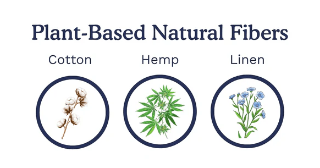
The frequency of clothing
The frequency of clothing refers to the vibrational signature of a fabric, which can be influenced by the fabric's material, weave, and texture. Some speculate that the frequency of the clothing can influence a person's energy and health.
Natural fibers
Fabrics like linen, hemp, organic cotton, are said to have higher frequencies and resonate well with the human body.
Wool: Known for its softness, warmth, and moisture-wicking properties, wool has a vibrational frequency around 5000 mHz. This high-frequency range is believed to promote positive energy, healing, and relaxation. People also consider wool to have thermoregulatory benefits, helping maintain an optimal body temperature.
Linen: Derived from the flax plant, linen is a durable and breathable fabric with a vibrational frequency around 5000 mHz. Linen is known for its ability to absorb and release moisture efficiently, making it ideal for warmer climates. Its high-frequency vibration is believed to support physical detoxification and emotional clarity.
Organic Cotton: With its soft texture and hypoallergenic properties, organic cotton typically vibrates around 100 mHz. Organic cotton is free from pesticides and chemicals, allowing its natural energy to remain intact. This fabric is often linked with grounding and balancing energy.
Other Natural Fabrics: The study from our references did not test fabrics such as hemp, bamboo, and Tencel, but these materials are made from natural organic plants, trees and are gentle on those of us with sensitive skin. People with sensitive skin are unable to wear synthetics so this maybe telling us something about these other natural fibres. Hopefully someone will test more fabrics in the near future so we can find out more.
What is the frequency of hemp fabric? While we haven’t been able to find any frequency test done specifically for hemp it is likely it would rank rather higher among other fabrics so long as it was 100% hemp. Hemp is processes similar to linen and as close to a natural state as any other natural fabric.
Synthetic fibers
Fabrics like polyester, nylon, spandex, and acrylic are said to have lower frequencies and can disrupt a person's natural energy flow.
Polyester: One of the most commonly used synthetic fibers, polyester typically has a much lower vibrational frequency, around 15 mHz. Because it is made from petroleum, polyester’s frequency is often considered disruptive or imbalanced. This can negatively impact the wearer’s energy field.
Nylon: Another widely used synthetic fabric, nylon vibrates in a similar low range around 15 mHz. Like polyester, nylon is derived from petrochemicals and is associated with lower vibrational frequencies. This can lead to feelings of discomfort, irritability, and fatigue when worn for extended periods.
Acrylic: Known for its wool-like texture, acrylic is another synthetic fiber with a low vibrational frequency, typically around 15 mHz. Due to its plastic nature, acrylic is often regarded as having an even more disruptive impact on energy fields.
The frequency of the human body is best described by mechanical resonant frequencies, which vary with posture and body part, with the whole standing body having a resonant frequency around 12 Hz and the seated body around 5 Hz, as found in studies on whole-body vibration. While some sources also mention higher MHz vibrational frequencies for cells and general body health, these are not as scientifically established as the mechanical frequencies and are sometimes associated with alternative health practices.
Mechanical Resonant Frequencies
These are the frequencies at which the body naturally vibrates and are influenced by its physical structure and mass.
The fundamental resonant frequency of the entire standing human body is approximately 12 Hz, with individual and population-based averages around 12.3 Hz.
When seated, the whole-body resonant frequency is lower, around 5 Hz, due to changes in posture and body mechanics.
Fabrics with a higher frequency than the human body are said to be beneficial while those lower can cause or contribute to illness.
Natural fiber clothes are often considered better due to increased comfort, breathability, and skin-friendliness, as well as environmental benefits like biodegradability and reduced pollution. While they can be more expensive and sometimes require special care, natural fibers like cotton, linen, and hemp offer superior softness, moisture-wicking properties, and fewer chemical residues compared to synthetic alternatives made from plastic.
Advantages of Natural Fibers
Comfort and Breathability:
Natural fibers are generally softer, more comfortable, and allow skin to breathe, making them ideal for sensitive skin and warm weather.
Skin-Friendly Properties:
Many natural fibers are hypoallergenic and have antibacterial properties, reducing the risk of skin irritation.
Environmental Benefits:
Natural fibers are biodegradable, meaning they decompose more easily at the end of their life. They are also renewable and often produced with fewer harmful chemicals.
Moisture Management:
Natural fibers, especially wool, excel at managing moisture and regulating temperature, keeping you comfortable in various conditions.
They tend to absorb less odor than synthetic fibers, allowing for more wears between washes.
Health Benefits:
They will help balance your hormones since synthetic fibers are made from plastic which affect hormones negatively.
They can help raise your vibration since the frequency of these fibers are higher.
Why Choose Natural Fibers
For sensitive skin or if you prefer a softer feel.
When you want to reduce your environmental impact.
Great for everyday wear and warm-weather clothing.
If you're looking for breathable and moisture-regulating activewear.
To help raise your frequency.
To help balance your hormones.
Dr. Heidi Yellen's 2003 study: https://www.scribd.com/document/235007178/Scientific-Details-of-the-Linen-Frequency-Study#












